ABOUT US
Our sawn constructional veneers have vastly superior working properties to the sliced type: The sawing process we use in their manufacture doesn’t rupture the fibre structure so tearing and cracking doesn’t occur making handling and processing much easier.
JOHN MACGREGOR
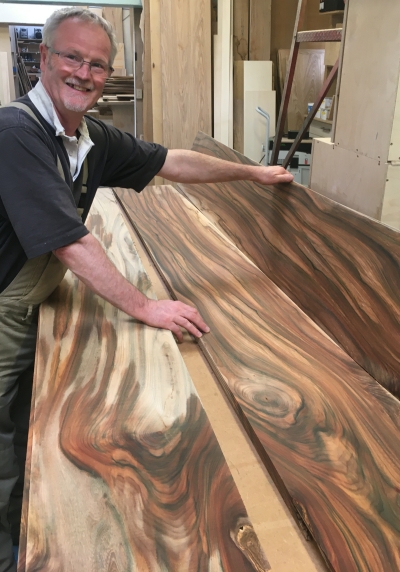
Owner and boss John MacGregor’s interest in working with wood started early. He says “I was born and raised in the Scottish Highlands and was originally inspired by my woodwork teacher at school following which I studied construction technology for 3 years in Edinburgh and Glasgow. In 1998 I took the opportunity to move to the cabinet making heartland of Germany to study a full time apprenticeship with a professional workshop. In 2001 I set up a workshop of my own back here in the Highlands from where things have progressed somewhat.
Eventually it became clear that if it was possible to manufacture sawn veneers wide enough this would be a game changer. Sawn veneer has become more of a passion for me than making furniture itself and one reason for this is to give other makers an opportunity to show the true beauty of wood, in particular our own native hardwoods.
Away from the workshop I enjoy walking in our beautiful local Sutherland countryside and still manage to play the occasional round of golf at our local links course (although it looks like my two children will be better much than me at that game).”
PRODUCT DESCRIPTION:
SPECIES AVAILABILITY:
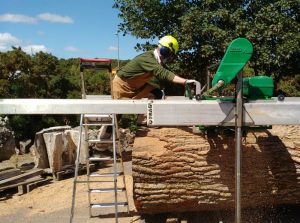
Our veneers are cut from any solid timber that is available on the open market: from freshly sawn hardwood logs to kiln dried boards. We also cut veneer from logs recovered in the Scottish Highlands. The timber from these logs is not widely available on the open market as they are often purchased by specialist ‘loggers’ and sent abroad to be cut into high-end veneers, but we usually manage to purchase some for our customers.
We are also able to cut veneer from your timber if required – logs or boards.
WHAT WE PROVIDE – TECHNICAL SPECIFICATIONS
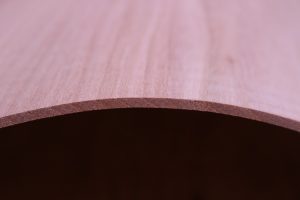
Veneer available in widths from 40 to 300mm. Standard thicknesses of 1mm up to 6mm. Other thicknesses available by our bespoke service.
Standard lengths up to 2450mm. Bespoke service available for lengths up to 5200mm.
All our veneers are ‘dressed’ using our special process so they don’t have to be sanded prior to finish application. Additionally de-nibbing between coats is minimal and can be carried out using a Mirlon VF 360 soft fleece. Full grain texturing is available on veneers of minimum thickness 2.2mm.
FIELDS OF APPLICATION:
Solid timber sawn veneers can be used for furniture making; interior joinery; decorative panels and flooring. Also particularly suited to high quality instrument making and model making.
Supplied to: professional furniture manufacturers; cabinet makers; flooring manufacturers; hobby, craft and DIY enthusiasts.
Due to their mechanical properties and thickness sawn constructional veneers can be pressed onto a substrate using manual cramping. This makes engineered component manufacture possible for smaller makers without access to a veneer press.
GET MUCH BETTER RESULTS WITH SAWN VENEER
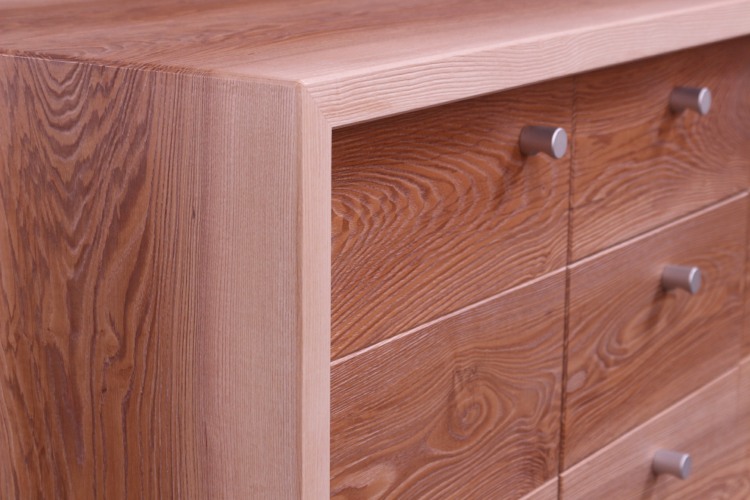 This example of a cabinet built in our workshop uses attractive random matched sawn constructional veneer. The mechanical/movement properties that would normally be associated with solid timber are not an issue here. For a substrate any good quality plywood, blockboard, MDF or chipboard can be used.
This example of a cabinet built in our workshop uses attractive random matched sawn constructional veneer. The mechanical/movement properties that would normally be associated with solid timber are not an issue here. For a substrate any good quality plywood, blockboard, MDF or chipboard can be used.
The cabinet in the adjacent picture clearly shows a simple construction and ease of timber selection and matching. The cabinet uses our pre-textured veneer so there is much less finishing work needed on the assembled cabinet (almost no sanding – just a quick clean up). Also strong and stable ‘biscuit’ mitred carcase joints are used to give flowing grain patterns. The same veneer is used for faces and edges. In this example the veneer is 2.2mm thick which allows plenty for a good chamfer or round – up to 3.5 x 3.5mm, and very easy edge/arris finishing.
FURTHER BENEFITS of SAWN VENEERS:
-
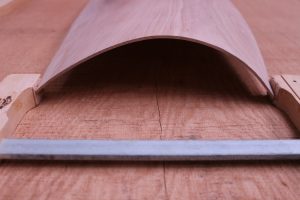
Demonstration of lateral flex without cracking A sawn veneer is just a very thin plank of wood cut from solid timber with an extremely powerful precision band saw. This specialized cutting process means the timber retains its’ natural fibre structure and so behaves and finishes exactly as solid timber – even better as ‘character cuts’ that can be impossible to work with in solid timber now become manageable and can be incorporated into furniture and interiors as never before – see image ….
- Sawn veneers can be cut (for jointing) on a table saw with a standard or thin kerf saw blade.
- Edging material can also be accurately cut on the saw.
- Symmetry/asymmetry is easier as batches are not as repetitive as sliced veneer. Although symmetry is clearly there it is easier to manage, not so restrictive and more natural (see images).
- Layons can be jointed with good quality vinyl packing tape.
- Alternatively the ‘MacGregor’ version of sawn veneer furniture construction can be used to produce components without having to joint veneer sheets – see The World of Sawn Veneer……..
- Won’t tear or crack during handling/processing.
- Veneers are ‘dressed’ using our special process so they don’t have to be sanded prior to application of surface coating (oil or lacquer). Additionally de-nibbing between coats is minimal and can be carried out using a Mirlon VF 360 soft fleece.
